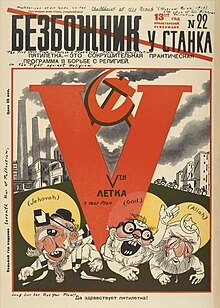 | |
| Editor | Maria Kostelovskaya |
|---|---|
| Categories | Antireligious |
| Frequency | Monthly |
| Founded | 1923 |
| Final issue | 1931 |
| Country | Soviet Union |
| Based in | Moscow |
| Language | Russian |
Bezbozhnik u Stanka (Russian: «Безбожник у станка», lit. 'The Godless at the Workbench') was a monthly and later biweekly antireligious magazine of the Moscow Committee of the AUCP(b). Published from December 1923 to 1931, it circulated roughly 35 thousand to 70 thousand copies per issue.
The magazine criticized religion from the point of view of Marxism. On its pages the questions of socialist construction, culture, anti-religious propaganda in the USSR were highlighted in a popular form, the connection of religious organizations with the exploiting classes was revealed. Criticism was directed at the Christian, Jewish, Muslim, Buddhist and other religions. The magazine had the following sections: 1) the class essence of religion, 2) religion and the class struggle abroad, 3) eastern religions, 4) in the camp of white emigrants, 5) the significance of religion in the USSR, as brakes on material and spiritual culture, 6) the reactionary role of religions in family life, 7) religion and class struggle under tsarism, 8) religion and revolution, 9) pioneer page, 10) methods of anti-religious propaganda, 11) materialism and idealism (religion), as two class systems of understanding of nature, human and social life, 12) questions and answers, 13) bibliography. The editor-in-chief of the magazine Bezbozhnik u Stanka was Maria Kostelovskaya.
The first edition of the Great Soviet Encyclopedia reports that the magazine from the moment of its appearance began to penetrate abroad, especially to America, and met with lively interest from the workers; 1924, in the House of Lords, the Archbishop of Canterbury protested against the distribution of the magazine in England, saying that the Bolsheviks "encroached on the highest achievement of human culture" – on religion; from the spring of 1925 the magazine in England was banned.
However, in publications and illustrations of the magazine, often brutal attacks against religion were made, which offended the religious feelings of believers. For this, the magazine has been criticized more than once in the party press and by party organizations.
Examples of issues
-
 The Buddha is depicted as a samovar dispensing gold.
The Buddha is depicted as a samovar dispensing gold.
-
 Jehovah is shown being used as a bloodhound.
Jehovah is shown being used as a bloodhound.
-
 Men are depicted paying for the saliva of a Mullah.
Men are depicted paying for the saliva of a Mullah.
-
 Workers are shown replacing Transfiguration Day with Industrialization day.
Workers are shown replacing Transfiguration Day with Industrialization day.
-
 The child mascot of the magazine has knocked God, Capitalism, and the Pope off of the Earth.
The child mascot of the magazine has knocked God, Capitalism, and the Pope off of the Earth.
-
 The Red Army advances on fascists and various religious figures.
The Red Army advances on fascists and various religious figures.
See also
- Bezbozhnik (newspaper)
- Council for Religious Affairs
- Religion in the Soviet Union
- State atheism
- USSR anti-religious campaign (1928–1941)
References
- "Bezbozhnik u Stanka -- index".
- "Просмотр документа - dlib.rsl.ru". dlib.rsl.ru.
- ^ Православие: Словарь атеиста / Под ред. Н. С. Гордиенко. — М.: Политиздат, 1988. — 270 с.; 17 см.; ISBN 5-250-00079-7 : / Стр. 35
- "БСЭ1/«Безбожник у станка» — Викитека". ru.wikisource.org.
Notes
- Atheistic Dictionary / . - 2-е изд., испр. и доп. - Москва : Политиздат, 1985. - 512 с.; 20 см / С. 51
- Siegelbaum, Lewis H. Soviet state and society between revolutions, 1918-1929 / Lewis H. Siegelbaum. - . - Cambridge : Cambridge univ. press, 1994. - XIII, 284 с.; 23 см. - (Cambridge soviet paperbacks; 8).; ISBN 0-521-36987-8 (paperback)/ p. 161
- 1923 establishments in the Soviet Union
- 1931 disestablishments in the Soviet Union
- Anti-Christian sentiment in Russia
- Anti-religious campaign in the Soviet Union
- Atheism publications
- Magazines published in the Soviet Union
- Magazines established in 1923
- Magazines disestablished in 1931
- Magazines published in Moscow
- Monthly magazines published in Russia
- Persecution of Muslims
- Propaganda in the Soviet Union
- Propaganda newspapers and magazines
- Religious persecution by communists
- Russian-language magazines
- Anti-Islam sentiment in the Soviet Union